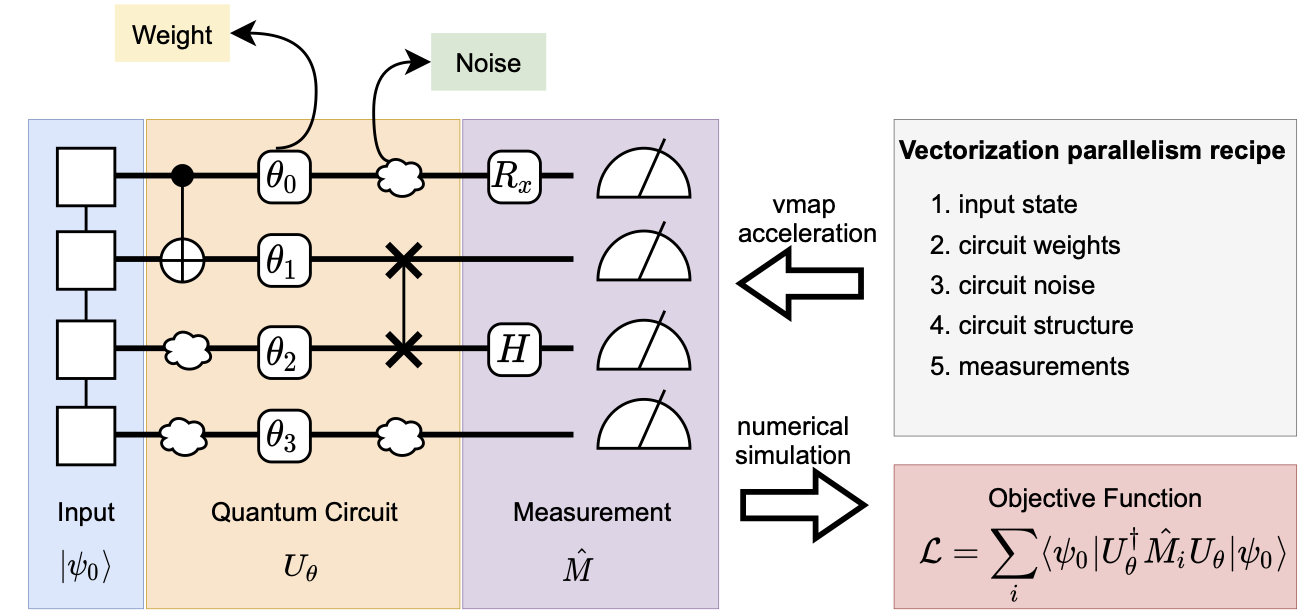在量子电路模拟中使用 vmap#
概述#
我们将现代机器学习库的高级特性 vmap 引入到量子电路模拟中。 通过对量子电路模拟的不同成分进行映射,我们可以高效地实现变分量子算法。 值得注意的是,在以下用例中,vmap 与 jit 和 AD 一起支持,可呈现高效的可微分模拟。
支持 vmap 范式的成分如下图所示。

我们有两种不同类型的 vmap API,第一种是 vmap 而第二种是vectorized_value_and_grad,又名vvag。 后者还可以返回一批不同电路的梯度信息。
如果需要对梯度和函数值进行批量评估,则可以通过 vectorized_value_and_grad 来完成。在最简单的情况下,考虑一个函数 \(f(x,y)\) 其中 \(x\in R^p,y\in R^q\) 都是向量,并且希望同时评估 \(f(x,y)\) 和 \(\sum_x\nabla_y f( x,y) = \sum_x\left ( \frac{\partial f(x,y_1)}{\partial y_1},\ldots, \frac{\partial f(x,y_q)}{\partial y_q}\right )^\top\) 在输入 \(x\) 的批次 \(x_1, x_2,\ldots, x_k\) 上。这是通过创建一个新的矢量化值和梯度函数来实现的:
\begin{equation} f_{vvg}\left( \begin{pmatrix} \leftarrow x_1 \rightarrow\\ \vdots \\ \leftarrow x_k \rightarrow\end{pmatrix}, y \right) = \begin{pmatrix} \begin{pmatrix}f(x_1, y) \\ \vdots \\ f(x_k,y)\end{pmatrix},\sum_{i=1}^k \nabla_y f(x_i,y) \end{pmatrix} \end{equation}
它将批处理输入表示为 \(k\times p\) 张量作为第零个参数,并将我们希望区分的变量作为第一个参数。 输出是在所有点 \((x_i,y)\) 处评估的函数值向量,以及所有这些点的平均梯度。
设置#
[2]:
import numpy as np
import tensorcircuit as tc
tc.set_backend("tensorflow")
print(tc.__version__)
nwires = 5
nlayers = 2
batch = 6
0.0.220509
vmap 输入量子态#
用例:量子机器学习任务中输入状态的批处理。
批量输入状态处理的应用请参考MNIST QML 教程。
最小案例#
[3]:
def f(inputs, weights):
c = tc.Circuit(nwires, inputs=inputs)
c = tc.templates.blocks.example_block(c, weights, nlayers=nlayers)
loss = c.expectation([tc.gates.z(), [2]])
loss = tc.backend.real(loss)
return loss
f_vg = tc.backend.jit(tc.backend.vvag(f, argnums=1, vectorized_argnums=0))
f_vg(tc.backend.ones([batch, 2**nwires]), tc.backend.ones([2 * nlayers, nwires]))
[3]:
(<tf.Tensor: shape=(6,), dtype=float32, numpy=
array([10.88678, 10.88678, 10.88678, 10.88678, 10.88678, 10.88678],
dtype=float32)>,
<tf.Tensor: shape=(4, 5), dtype=complex64, numpy=
array([[ 0.0000000e+00+1.3064140e+02j, -1.1444092e-05+1.3064142e+02j,
0.0000000e+00+1.3064140e+02j, 0.0000000e+00+1.3064139e+02j,
0.0000000e+00+0.0000000e+00j],
[-1.9073486e-06-5.1765751e-06j, -5.1105431e+01-5.7347143e-07j,
-8.1339760e+01-6.6063179e+01j, -5.1105446e+01+3.3477118e-06j,
-7.6293945e-06+1.5500746e-07j],
[ 0.0000000e+00+8.4607742e+01j, -1.3292285e+02+1.1209973e+02j,
-1.3292284e+02+1.1209971e+02j, 1.5258789e-05+8.4607750e+01j,
0.0000000e+00+0.0000000e+00j],
[ 1.9073486e-06+5.9908474e+01j, -1.5258789e-05-1.9285599e+01j,
-8.1339752e+01+3.8049275e-06j, 3.8146973e-06-1.9285591e+01j,
-9.5367432e-06+5.9908482e+01j]], dtype=complex64)>)
vmap 电路权重#
用例:批量 VQE,其中同时优化不同的随机初始化参数。
关于批量 VQE 的应用,请参考 TFIM VQE 教程。
最小案例#
[4]:
def f(weights):
c = tc.Circuit(nwires)
c = tc.templates.blocks.example_block(c, weights, nlayers=nlayers)
loss = c.expectation([tc.gates.z(), [2]])
loss = tc.backend.real(loss)
return loss
f_vg = tc.backend.jit(tc.backend.vvag(f, argnums=0, vectorized_argnums=0))
f_vg(tc.backend.ones([batch, 2 * nlayers, nwires]))
[4]:
(<tf.Tensor: shape=(6,), dtype=float32, numpy=
array([-2.9802322e-08, -2.9802322e-08, -2.9802322e-08, -2.9802322e-08,
-2.9802322e-08, -2.9802322e-08], dtype=float32)>,
<tf.Tensor: shape=(6, 4, 5), dtype=complex64, numpy=
array([[[ 1.1614500e-08+2.1480869e-08j, -9.2439478e-10-1.8808342e-08j,
2.6397275e-08-8.0511313e-09j, 2.7981415e-08-1.6564460e-08j,
0.0000000e+00+0.0000000e+00j],
[ 4.1470027e-09-1.9918247e-08j, -7.7494953e-09+9.5806874e-09j,
0.0000000e+00-1.3076999e-08j, 1.2109957e-09+3.2571617e-08j,
-1.0110498e-08+1.6951747e-08j],
[ 1.1614500e-08-1.0295013e-08j, -1.6102263e-08+2.5077789e-08j,
-3.2204525e-08+5.0155577e-08j, 1.8346144e-08-3.5633683e-09j,
0.0000000e+00+0.0000000e+00j],
[-7.1439974e-09-3.3070933e-09j, 0.0000000e+00+6.8412485e-09j,
1.4287995e-08-9.5050003e-09j, -7.1439974e-09-6.5384995e-09j,
-2.3792996e-08-7.8779987e-09j]],
[[ 1.1614500e-08+2.1480869e-08j, -9.2439478e-10-1.8808342e-08j,
2.6397275e-08-8.0511313e-09j, 2.7981415e-08-1.6564460e-08j,
0.0000000e+00+0.0000000e+00j],
[ 4.1470027e-09-1.9918247e-08j, -7.7494953e-09+9.5806874e-09j,
0.0000000e+00-1.3076999e-08j, 1.2109957e-09+3.2571617e-08j,
-1.0110498e-08+1.6951747e-08j],
[ 1.1614500e-08-1.0295013e-08j, -1.6102263e-08+2.5077789e-08j,
-3.2204525e-08+5.0155577e-08j, 1.8346144e-08-3.5633683e-09j,
0.0000000e+00+0.0000000e+00j],
[-7.1439974e-09-3.3070933e-09j, 0.0000000e+00+6.8412485e-09j,
1.4287995e-08-9.5050003e-09j, -7.1439974e-09-6.5384995e-09j,
-2.3792996e-08-7.8779987e-09j]],
[[ 1.1614500e-08+2.1480869e-08j, -9.2439478e-10-1.8808342e-08j,
2.6397275e-08-8.0511313e-09j, 2.7981415e-08-1.6564460e-08j,
0.0000000e+00+0.0000000e+00j],
[ 4.1470027e-09-1.9918247e-08j, -7.7494953e-09+9.5806874e-09j,
0.0000000e+00-1.3076999e-08j, 1.2109957e-09+3.2571617e-08j,
-1.0110498e-08+1.6951747e-08j],
[ 1.1614500e-08-1.0295013e-08j, -1.6102263e-08+2.5077789e-08j,
-3.2204525e-08+5.0155577e-08j, 1.8346144e-08-3.5633683e-09j,
0.0000000e+00+0.0000000e+00j],
[-7.1439974e-09-3.3070933e-09j, 0.0000000e+00+6.8412485e-09j,
1.4287995e-08-9.5050003e-09j, -7.1439974e-09-6.5384995e-09j,
-2.3792996e-08-7.8779987e-09j]],
[[ 1.1614500e-08+2.1480869e-08j, -9.2439478e-10-1.8808342e-08j,
2.6397275e-08-8.0511313e-09j, 2.7981415e-08-1.6564460e-08j,
0.0000000e+00+0.0000000e+00j],
[ 4.1470027e-09-1.9918247e-08j, -7.7494953e-09+9.5806874e-09j,
0.0000000e+00-1.3076999e-08j, 1.2109957e-09+3.2571617e-08j,
-1.0110498e-08+1.6951747e-08j],
[ 1.1614500e-08-1.0295013e-08j, -1.6102263e-08+2.5077789e-08j,
-3.2204525e-08+5.0155577e-08j, 1.8346144e-08-3.5633683e-09j,
0.0000000e+00+0.0000000e+00j],
[-7.1439974e-09-3.3070933e-09j, 0.0000000e+00+6.8412485e-09j,
1.4287995e-08-9.5050003e-09j, -7.1439974e-09-6.5384995e-09j,
-2.3792996e-08-7.8779987e-09j]],
[[ 1.1614500e-08+2.1480869e-08j, -9.2439478e-10-1.8808342e-08j,
2.6397275e-08-8.0511313e-09j, 2.7981415e-08-1.6564460e-08j,
0.0000000e+00+0.0000000e+00j],
[ 4.1470027e-09-1.9918247e-08j, -7.7494953e-09+9.5806874e-09j,
0.0000000e+00-1.3076999e-08j, 1.2109957e-09+3.2571617e-08j,
-1.0110498e-08+1.6951747e-08j],
[ 1.1614500e-08-1.0295013e-08j, -1.6102263e-08+2.5077789e-08j,
-3.2204525e-08+5.0155577e-08j, 1.8346144e-08-3.5633683e-09j,
0.0000000e+00+0.0000000e+00j],
[-7.1439974e-09-3.3070933e-09j, 0.0000000e+00+6.8412485e-09j,
1.4287995e-08-9.5050003e-09j, -7.1439974e-09-6.5384995e-09j,
-2.3792996e-08-7.8779987e-09j]],
[[ 1.1614500e-08+2.1480869e-08j, -9.2439478e-10-1.8808342e-08j,
2.6397275e-08-8.0511313e-09j, 2.7981415e-08-1.6564460e-08j,
0.0000000e+00+0.0000000e+00j],
[ 4.1470027e-09-1.9918247e-08j, -7.7494953e-09+9.5806874e-09j,
0.0000000e+00-1.3076999e-08j, 1.2109957e-09+3.2571617e-08j,
-1.0110498e-08+1.6951747e-08j],
[ 1.1614500e-08-1.0295013e-08j, -1.6102263e-08+2.5077789e-08j,
-3.2204525e-08+5.0155577e-08j, 1.8346144e-08-3.5633683e-09j,
0.0000000e+00+0.0000000e+00j],
[-7.1439974e-09-3.3070933e-09j, 0.0000000e+00+6.8412485e-09j,
1.4287995e-08-9.5050003e-09j, -7.1439974e-09-6.5384995e-09j,
-2.3792996e-08-7.8779987e-09j]]], dtype=complex64)>)
vmap 量子噪声#
用例:并行蒙特卡罗噪声模拟。
对于结合 vmapped Monte Carlo 噪声模拟和量子机器学习任务的应用程序,请参阅 noisy QML script。
最小案例#
[5]:
def f(weights, status):
c = tc.Circuit(nwires)
c = tc.templates.blocks.example_block(c, weights, nlayers=nlayers)
for i in range(nwires):
c.depolarizing(i, px=0.2, py=0.2, pz=0.2, status=status[i])
loss = c.expectation([tc.gates.x(), [2]])
loss = tc.backend.real(loss)
return loss
f_vg = tc.backend.jit(tc.backend.vvag(f, argnums=0, vectorized_argnums=1))
def g(weights):
status = tc.backend.implicit_randu(shape=[batch, nwires])
return f_vg(weights, status)
g(tc.backend.ones([2 * nlayers, nwires]))
[5]:
(<tf.Tensor: shape=(6,), dtype=float32, numpy=
array([ 0.34873545, -0.34873545, -0.34873545, -0.34873545, -0.34873545,
0.34873545], dtype=float32)>,
<tf.Tensor: shape=(4, 5), dtype=complex64, numpy=
array([[-8.8614023e-01-1.7026657e-08j, 5.7763958e-01+2.3834804e-01j,
5.7763910e-01+2.3834780e-01j, -8.8614047e-01+1.2538894e-07j,
0.0000000e+00+0.0000000e+00j],
[ 0.0000000e+00+6.9313288e-01j, 3.6122650e-01-1.1496974e-02j,
-5.2079970e-01-1.7869800e-01j, 3.6122644e-01-1.1496985e-02j,
-2.9802322e-08+6.9313288e-01j],
[-5.9604645e-08-1.0189922e+00j, -3.0850098e-01-1.4861794e-07j,
-3.0850050e-01-2.2304604e-08j, 5.9604645e-08-1.0189921e+00j,
0.0000000e+00+0.0000000e+00j],
[ 0.0000000e+00+3.1868588e-02j, -8.9406967e-08+2.5656950e-01j,
-2.9802322e-08-1.9999983e+00j, -2.9802322e-08+2.5656945e-01j,
-1.1920929e-07+3.1868652e-02j]], dtype=complex64)>)
vmap 电路结构#
用例:可微量子架构搜索 (DQAS)。
有关 DQAS 应用程序的更多详细信息,请参阅 DQAS 教程。
最小案例#
[6]:
eye = tc.gates.i().tensor
x = tc.gates.x().tensor
y = tc.gates.y().tensor
z = tc.gates.z().tensor
def f(params, structures):
c = tc.Circuit(nwires)
for i in range(nwires):
c.H(i)
for j in range(nlayers):
for i in range(nwires - 1):
c.cz(i, i + 1)
for i in range(nwires):
c.unitary(
i,
unitary=structures[i, j, 0]
* (
tc.backend.cos(params[i, j, 0]) * eye
+ tc.backend.sin(params[i, j, 0]) * x
)
+ structures[i, j, 1]
* (
tc.backend.cos(params[i, j, 1]) * eye
+ tc.backend.sin(params[i, j, 1]) * y
)
+ structures[i, j, 2]
* (
tc.backend.cos(params[i, j, 2]) * eye
+ tc.backend.sin(params[i, j, 2]) * z
),
)
loss = c.expectation([tc.gates.z(), (2,)])
return tc.backend.real(loss)
structures = tc.backend.ones([batch, nwires, nlayers, 3])
params = tc.backend.ones([nwires, nlayers, 3])
f_vg = tc.backend.jit(tc.backend.vvag(f, argnums=0, vectorized_argnums=1))
f_vg(params, structures)
[6]:
(<tf.Tensor: shape=(6,), dtype=float32, numpy=
array([2.4917054e+08, 2.4917054e+08, 2.4917054e+08, 2.4917054e+08,
2.4917054e+08, 2.4917054e+08], dtype=float32)>,
<tf.Tensor: shape=(5, 2, 3), dtype=complex64, numpy=
array([[[-4.8252989e+08+2.3603376e+07j, -6.4132224e+08+1.1064736e+08j,
-4.5701562e+08-7.4987272e+07j],
[-5.4175347e+08+5.2096408e+07j, -5.5254317e+08-4.6495180e+07j,
-4.5219101e+08-5.6013205e+06j]],
[[-7.1430163e+08-1.2090212e+08j, -6.2410163e+08-4.1363908e+07j,
-3.9189485e+08+4.0016840e+06j],
[-5.8365677e+08+9.4236816e+07j, -5.7693280e+08-9.7727496e+07j,
-3.9540646e+08+3.4906362e+06j]],
[[-5.9637555e+08+8.9477632e+07j, -7.6615610e+08+1.1949610e+08j,
-3.8039136e+08-4.7556400e+07j],
[-1.1637092e+09-4.0144461e+08j, -1.1735478e+09+4.5104198e+08j,
-1.5947418e+08+1.5322706e+07j]],
[[-7.1430170e+08-1.2090210e+08j, -6.2410170e+08-4.1363864e+07j,
-3.9189485e+08+4.0016840e+06j],
[-5.8365658e+08+9.4236840e+07j, -5.7693261e+08-9.7727496e+07j,
-3.9540637e+08+3.4906552e+06j]],
[[-4.8253002e+08+2.3603400e+07j, -6.4132237e+08+1.1064734e+08j,
-4.5701565e+08-7.4987248e+07j],
[-5.4175334e+08+5.2096460e+07j, -5.5254304e+08-4.6495116e+07j,
-4.5219091e+08-5.6013120e+06j]]], dtype=complex64)>)
vmap 电路测量#
用例:通过并行参数化测量加速泡利字符串和的评估。
有关在大型系统上通过 vmap 评估参数化测量的应用,请参阅 大型 vqe 示例脚本。
最小案例#
[7]:
def f(params, structures):
c = tc.Circuit(nwires)
c = tc.templates.blocks.example_block(c, params, nlayers=nlayers)
loss = tc.templates.measurements.parameterized_measurements(
c, structures, onehot=True
)
return loss
# 测量 X0 到 X3
structures = tc.backend.eye(nwires)
f_vvag = tc.backend.jit(tc.backend.vvag(f, vectorized_argnums=1, argnums=0))
f_vvag(tc.backend.ones([2 * nlayers, nwires]), structures)
WARNING:tensorflow:5 out of the last 5 calls to <function TensorFlowBackend.vectorized_value_and_grad.<locals>.wrapper at 0x7fe6cbed1af0> triggered tf.function retracing. Tracing is expensive and the excessive number of tracings could be due to (1) creating @tf.function repeatedly in a loop, (2) passing tensors with different shapes, (3) passing Python objects instead of tensors. For (1), please define your @tf.function outside of the loop. For (2), @tf.function has experimental_relax_shapes=True option that relaxes argument shapes that can avoid unnecessary retracing. For (3), please refer to https://www.tensorflow.org/guide/function#controlling_retracing and https://www.tensorflow.org/api_docs/python/tf/function for more details.
[7]:
(<tf.Tensor: shape=(5,), dtype=float32, numpy=
array([-0.3118263 , 0.00371493, 0.3487355 , 0.00371514, -0.31182614],
dtype=float32)>,
<tf.Tensor: shape=(4, 5), dtype=complex64, numpy=
array([[ 1.6707865e+00-0.40178323j, -1.1992662e+00-0.23834792j,
-1.1992660e+00-0.2383478j , 1.6707866e+00-0.40178335j,
0.0000000e+00+0.j ],
[-1.8267021e-01-0.6483071j , 7.7729575e-02+0.58401704j,
-1.0082662e-01-0.52953976j, 7.7729806e-02+0.58401704j,
-1.8267024e-01-0.6483072j ],
[ 1.6707866e+00+0.19420199j, -1.1992658e+00+0.50487465j,
-1.1992657e+00+0.504875j , 1.6707867e+00+0.19420168j,
0.0000000e+00+0.j ],
[ 7.4505806e-09+0.99540246j, 1.4901161e-08+0.7925009j ,
-7.4505806e-09+0.71156096j, -7.4505806e-09+0.7925008j ,
2.2351742e-08+0.9954027j ]], dtype=complex64)>)